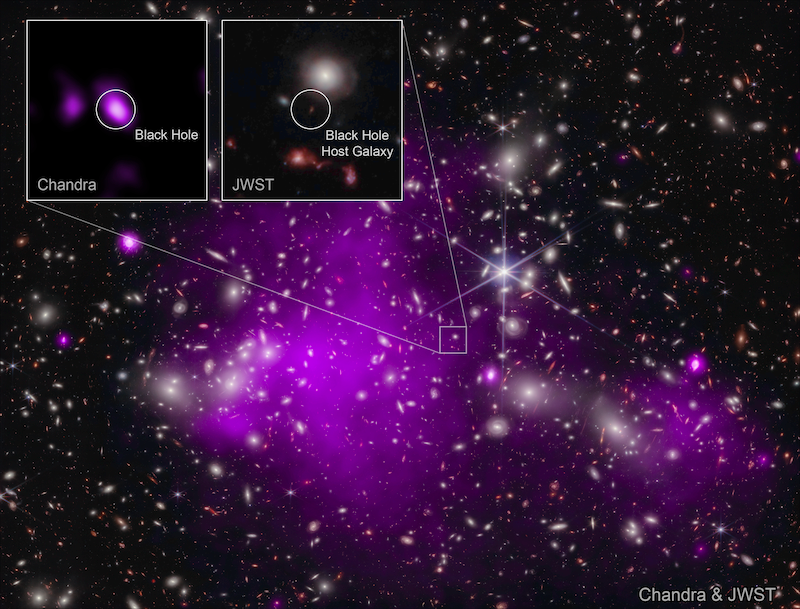Light from UHZ1 has traveled 13.2 billion light-years – a longer travel time than any other known black hole.

This composite image shows the galaxy cluster Abell 2744 as seen by JWST and the Chandra X-ray Observatory. Superimposed on the infrared image of the galaxies is a purple “haze” created by hot, X-ray-emitting gas in the cluster. But in the background lies the distant galaxy UHZ1 (right inset), whose central supermassive black hole is also emitting X-rays (left inset). Credit: X-ray: NASA/CXC/SAO/Ákos Bogdán; infrared: NASA/ESA/CSA/STScI; image processing: NASA/CXC/SAO/L. Frattare and K. Arcand
Astronomers recently reported that they detected the oldest and most distant black hole since the Big Bang. How do they know it's the oldest and most distant?
Heather
Mazatlan, Sinaloa, Mexico
A research team led by Akos Bogdan of the Center for Astrophysics | Harvard and Smithsonian A supermassive black hole (SMBH) has been discovered in UHZ1, a galaxy whose light has taken 13.2 billion light-years to reach us. This means that astronomers are observing it as it was 13.2 billion years ago, when the universe was just 3 percent of its current age, making it the oldest black hole yet detected.
The concept of distance is difficult to define when dealing with large expanses of space and time. So the simplest thing to do is to say that the distance UHZ1 travels in terms of light-time is 13.2 billion light-years, although that doesn't account for the expansion of the universe during the time the light has been traveling toward us. And the estimated distance and age of a galaxy will vary depending on the cosmological model used. But under any model, since UHZ1 has a longer light-time travel time than any other known black hole, it is also the most distant.
The physical characteristic of a galaxy that astronomers measure (from which they calculate its distance and age) is redshift: The stretching of light waves that occurs when a celestial body moves away from us. It is similar to the Doppler effect we experience with sound. When a police siren moves away from us, the frequency at which sound waves reach us is reduced, which we perceive as a lower pitch. The same principle applies to light.
The fact that all distant galaxies are moving away from us is due to the expansion of the universe. The farther away a galaxy is, the more space there is between us to expand, meaning that more distant objects appear to be moving away from us faster than closer objects. This principle, known as Hubble flow, allows scientists to estimate the distances of galaxies: the higher a galaxy's redshift, the faster it is moving away and the farther away it is from us. Astronomers denote the redshift as a value called heThe z-value of UHZ1 is 10.1, which corresponds to its light travel time of 13.2 billion years in standard cosmological models.
An additional stroke of luck allowed Bogdan’s research team to spot this supermassive black hole: the galaxy cluster Abell 2744 lies between us and UHZ1, at a distance of nearly 4 billion light-years, along the same line of sight. The gravity of Abell 2744’s substantial mass is bending the light from UHZ1 around it, focusing it like a magnifying glass. As a result of this gravitational lensing effect, UHZ1 appears four times brighter than it normally would. This allowed the James Webb Space Telescope and the Chandra X-ray Observatory to collect data that led the team to identify an X-ray source as UHZ1’s central black hole.
Edward Herrick-Gleason
Planetarium Director, Southworth Planetarium, University of Southern Maine, Portland, Maine









Leave feedback about this